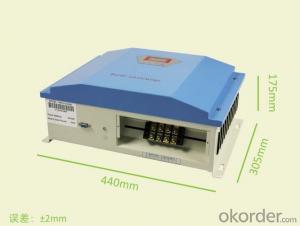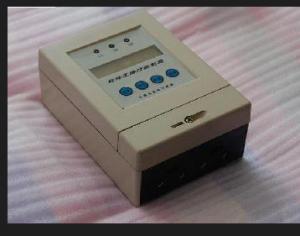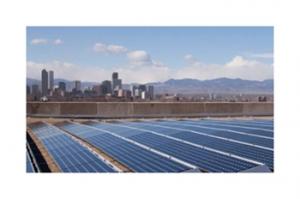Water Resistant Solar Charge Controller 2KW MPPT Charging Function
- Loading Port:
- Shanghai
- Payment Terms:
- TT or LC
- Min Order Qty:
- 1 unit
- Supply Capability:
- 10000 unit/month
OKorder Service Pledge
OKorder Financial Service
You Might Also Like
I. PRODUCT INTRODUCTION
Solar controller is control device which can control solar panel and transform solar energy into electricity then store to the battery bank. Solar controller is the most important part in off-grid system, whose performance has much effect on life expectancy and operation of the whole system, especially the battery expectancy. Or battery service life will be shortened by over charge or over discharge.
II. PERFORMANCE FEATURES
Superior military-grade components to ensure the product stability.
Perfect protection function, thus the system has higher reliability.
Check and set all operation parameters as requirement from LCD display.
PWM stepless unload mode, which burn the excess power into Dump load, making the battery charging in best status.
III. APPLICATION AREAS
Standalone Photovoltaic power station
Standalone Domestic household photovoltaic power system
Mobil communication base stations, expressway and other non-residential regions.
Coastal islands, remote mountainous, border posts for regions shortage of or without electricity.
Government demonstration projects, landscape lighting project etc.
IV. 2KW TECHNICAL PARAMETERS
Product model | WS20-48-N00 | WS20-96-N00 | WS20-110-N00 | WS20-120-N00 | WS20-220-N00 |
Rated battery power | 48V | 96V | 110V | 120V | 220V |
Rated solar input power | 2kW | 2kW | 2kW | 2kW | 2kW |
Floating charge voltage | 58V | 116V | 133V | 145V | 266V |
Max Open Circuit Voltage | 100V | 200V | 230V | 250V | 458V |
Dimensions (L x W x H) | 442×307×172 mm | ||||
Net weight | 7kg | ||||
Display mode | LCD | ||||
Cooling | Fan | ||||
Protection level | IP20(Indoor) | ||||
Quiescent current | ≤20 mA | ||||
Protection functions | Battery over charge; battery anti-reverse-connection; solar reverse charge protection; solar anti-reverse-connection; lightning protection. | ||||
Ambient temperature | -20~+55℃ | ||||
Ambient humidity | 0~93%, without condensing | ||||
Working altitude | ≤4000m | ||||
In order to serve our customers better, our company can adjust parameter configuration according to customer’s requirement. | |||||
- Q: Can a solar controller be used with solar panels that are connected to a solar ventilation system?
- Yes, a solar controller can be used with solar panels that are connected to a solar ventilation system. A solar controller is designed to regulate the charging and discharging of batteries in a solar power system. It ensures that the batteries are charged efficiently and protected from overcharging or overdischarging. In the case of a solar ventilation system, the solar panels generate electricity which is then used to power the ventilation system. The solar controller can be connected between the solar panels and the ventilation system to manage the flow of electricity. It can optimize the charging of batteries during sunlight hours and control the discharge of the stored energy when needed for the operation of the ventilation system. Using a solar controller with a solar ventilation system has several benefits. It helps to maximize the efficiency of the solar panels by ensuring that they are operating at their optimal voltage levels. It also protects the batteries from damage caused by overcharging or excessive discharge. Additionally, a solar controller can provide monitoring and control functions, allowing users to easily track and adjust the performance of the solar ventilation system. Overall, incorporating a solar controller into a solar ventilation system helps to enhance its performance, improve energy management, and ensure the longevity of the system.
- Q: How does a solar controller handle the protection against high voltage transients?
- A solar controller handles protection against high voltage transients by using various methods. One common approach is the use of surge protection devices, such as metal oxide varistors (MOVs), which can absorb and redirect excess voltage away from sensitive components. Additionally, some solar controllers incorporate built-in voltage regulation circuits to prevent voltage spikes from reaching critical components. These protective measures help safeguard the solar controller and connected devices from potential damage caused by high voltage transients.
- Q: How do you determine the optimal charging voltage for your batteries using a solar controller?
- To determine the optimal charging voltage for batteries using a solar controller, you need to refer to the manufacturer's specifications or guidelines for your specific batteries. The recommended charging voltage is usually provided by the battery manufacturer and may vary based on the battery chemistry and capacity. By adjusting the solar controller's settings within the recommended voltage range, you can ensure efficient and safe charging without overcharging or damaging the batteries.
- Q: Can a solar controller be used with a solar-powered ventilation system?
- Yes, a solar controller can be used with a solar-powered ventilation system. A solar controller is designed to regulate and optimize the charging and discharging of solar panels, and it can also control the output of a solar-powered ventilation system. By connecting the solar controller between the solar panels and the ventilation system, it ensures that the system operates efficiently and effectively, maximizing the use of solar energy.
- Q: Can a solar controller be used with solar panels that are connected to a battery backup system?
- Yes, a solar controller can be used with solar panels that are connected to a battery backup system. A solar controller regulates the charging process of the battery by monitoring the voltage and current from the solar panels. It ensures that the battery is charged efficiently and protects it from overcharging. Therefore, it is an essential component in a solar panel system that is connected to a battery backup system.
- Q: Can a solar controller be used in a solar-powered heating system?
- Yes, a solar controller can be used in a solar-powered heating system. A solar controller regulates the flow of electricity from the solar panels to the heating system, ensuring optimal performance and preventing damage to the system. It helps manage the temperature and power output, allowing the heating system to efficiently utilize the solar energy for heating purposes.
- Q: Can a solar controller be used with deep-cycle batteries?
- Yes, a solar controller can be used with deep-cycle batteries. In fact, a solar controller is specifically designed to regulate the charging process of batteries, including deep-cycle batteries, by preventing overcharging and optimizing the charging efficiency.
- Q: How do I integrate a solar controller with an existing solar panel system?
- To integrate a solar controller with an existing solar panel system, you will need to follow these steps: 1. Determine the compatibility: Ensure that the solar controller you want to integrate is compatible with your existing solar panel system. Check the voltage and current ratings of both the solar panels and the controller to ensure they match. 2. Disconnect the existing connections: Turn off the power supply to the solar panel system and disconnect all the existing connections between the solar panels and the charge controller (if any). 3. Mount the solar controller: Find a suitable location to mount the solar controller. It should be near the battery bank and easily accessible for monitoring and maintenance. 4. Connect the solar panels: Connect the positive and negative terminals of the solar panels to the corresponding input terminals on the solar controller. Ensure proper polarity. 5. Connect the battery bank: Connect the positive and negative terminals of the battery bank to the corresponding output terminals on the solar controller. Again, ensure proper polarity. 6. Check the settings: Set the appropriate charging parameters on the solar controller according to the battery type and capacity. This may include voltage thresholds, charging modes, and temperature compensation. 7. Reconnect the power supply: Once everything is properly connected and configured, reconnect the power supply to the solar panel system. The solar controller will now regulate the charging of the battery bank, optimizing the performance and lifespan of your solar panel system.
- Q: How does a solar controller handle the protection against lightning strikes?
- A solar controller typically does not handle the direct protection against lightning strikes. Instead, it ensures the safety of the solar panel system by implementing certain protective measures. These measures may include surge protection devices, grounding systems, and lightning arrestors that divert the electrical current from lightning strikes away from the solar panels, thus safeguarding the system from potential damage.
- Q: Can a solar controller be used in a solar-powered space exploration mission?
- Yes, a solar controller can be used in a solar-powered space exploration mission. A solar controller is essential for regulating the charging and discharging of batteries and ensuring the efficient use of solar energy in powering the spacecraft's systems and instruments. It helps manage the flow of power from the solar panels, preventing overcharging and damage to the batteries, thus ensuring the mission's success and longevity in space.
Send your message to us
Water Resistant Solar Charge Controller 2KW MPPT Charging Function
- Loading Port:
- Shanghai
- Payment Terms:
- TT or LC
- Min Order Qty:
- 1 unit
- Supply Capability:
- 10000 unit/month
OKorder Service Pledge
OKorder Financial Service
Similar products
Hot products
Hot Searches
Related keywords

























